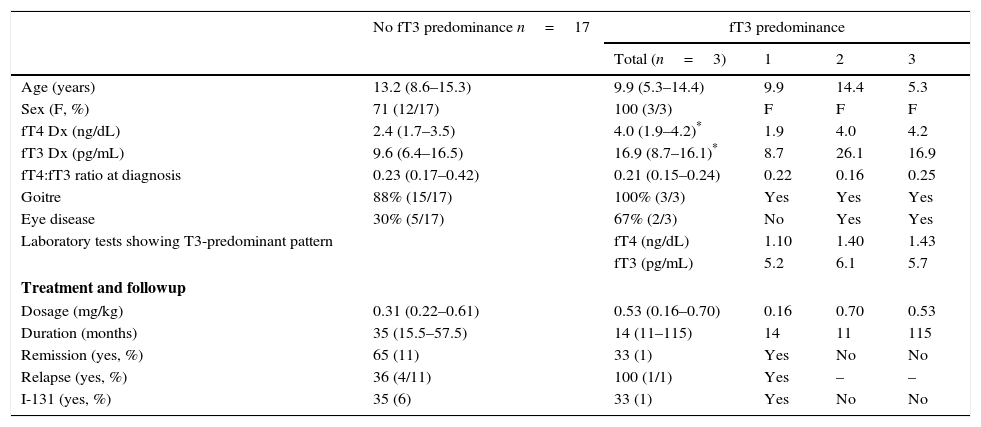Graves’ disease (GD) is uncommon in the paediatric age group. In these patients, the course of the disease tends to be more severe, with a lesser frequency of remissions and a greater number of relapses.1,2 The initial diagnosis is usually made based on clinical manifestations and later confirmed by the detection of decreased thyroid-stimulating hormone (TSH) levels and high serum levels of free thyroxine (fT4) and free triiodothyronine (fT3) associated with the presence of thyroid-stimulating immunoglobulin (TSI). The first-line treatment consists of the administration of antithyroid drugs. A form of GD known as triiodothyronine-predominant GD (T3-P-GD) has been described in the literature. It is characterised by sustained high levels of fT3 with normal or low levels of fT4 during part of the treatment and the followup.1,3 This form, described in up to 10% of adult patients, is associated with a more severe course of disease and a poorer response to treatment. Its pathogenesis is not well understood, although type 1 and 2 deionidases, which catalyse the conversion of T4 to T3 and increase intracellular levels of T3, are known to be overexpressed in the thyroid tissues of these patients.4,5 T3-P-GD had not been described in the paediatric population until the recent publication of the data of a French cohort of 60 paediatric patients with GD in which the T3-predominant pattern was identified in 13% of the patients. These patients had more severe forms of disease, were diagnosed earlier, and required higher doses of antithyroid drugs to control their disease.6
In our experience, in a cohort of 20 paediatric patients with GD in which we analysed the clinical data at the time of diagnosis, the levels of TSH, fT3 (normal range [NR] 1.7–4.53pg/mL), fT4 (NR 0.7–1.48ng/dL), and the fT4:fT3 ratio, as well as their clinical outcomes in relation to the treatment received, T3-P-GD was identified in three patients that exhibited clinical and laboratory patterns similar to those described in the case series published by Harvengt et al.6 All patients in the cohort received pharmacological treatment with thionamide-derived antithyroid drugs. The overall mean age at diagnosis of GD was 12.5 years (8.5–15.1), and 75% of the patients were female. Remission occurred in 12/20 patients (60%) after a mean 41.5 months of treatment (18–58.7), and relapses in 5/12 (42%). Of all the patients, three (15%) had transient fT3 predominance over fT4 after initiation of treatment, with the pattern lasting between one and four months. The data for these patients showed that they have higher levels of fT4 and fT3 at diagnosis, and a tendency to be diagnosed at earlier ages, have a higher prevalence of eye disease, and require higher doses of antithyroid medication to control their GD (Table 1). We did not find any differences in the levels of TSI between both groups.
Clinical, laboratory and follow-up characteristics of the patients.
| No fT3 predominance n=17 | fT3 predominance | ||||
|---|---|---|---|---|---|
| Total (n=3) | 1 | 2 | 3 | ||
| Age (years) | 13.2 (8.6–15.3) | 9.9 (5.3–14.4) | 9.9 | 14.4 | 5.3 |
| Sex (F, %) | 71 (12/17) | 100 (3/3) | F | F | F |
| fT4 Dx (ng/dL) | 2.4 (1.7–3.5) | 4.0 (1.9–4.2)* | 1.9 | 4.0 | 4.2 |
| fT3 Dx (pg/mL) | 9.6 (6.4–16.5) | 16.9 (8.7–16.1)* | 8.7 | 26.1 | 16.9 |
| fT4:fT3 ratio at diagnosis | 0.23 (0.17–0.42) | 0.21 (0.15–0.24) | 0.22 | 0.16 | 0.25 |
| Goitre | 88% (15/17) | 100% (3/3) | Yes | Yes | Yes |
| Eye disease | 30% (5/17) | 67% (2/3) | No | Yes | Yes |
| Laboratory tests showing T3-predominant pattern | fT4 (ng/dL) | 1.10 | 1.40 | 1.43 | |
| fT3 (pg/mL) | 5.2 | 6.1 | 5.7 | ||
| Treatment and followup | |||||
| Dosage (mg/kg) | 0.31 (0.22–0.61) | 0.53 (0.16–0.70) | 0.16 | 0.70 | 0.53 |
| Duration (months) | 35 (15.5–57.5) | 14 (11–115) | 14 | 11 | 115 |
| Remission (yes, %) | 65 (11) | 33 (1) | Yes | No | No |
| Relapse (yes, %) | 36 (4/11) | 100 (1/1) | Yes | – | – |
| I-131 (yes, %) | 35 (6) | 33 (1) | Yes | No | No |
Data expressed as percentage, median and interquartile range (Q1–Q3).
Dx, diagnosis; F, female; fT3 predominance, presence of elevated fT3 with normalisation of fT4 during treatment with antithyroid drugs; fT3, (free T3) normal range, 1.7–4.53pg/mL; fT4, (free T4) normal range, 0.7–1.48ng/dL.
Triiodothyronine-predominant GD also occurs in the paediatric age group. In these patients, GD tends to have an earlier onset, a more severe course and a poorer response to treatment. Our experience is based on a small number of cases, but nevertheless we believe that it is important to identify these patients as soon as they are diagnosed by the serial measurement of not only fT4, but also fT3 levels. A better hormonal and molecular characterisation of these patients (study of type 1 and type 2 iodothyronine deiodinases DIO1, DIO2) could be significant in the diagnosis of this subset of patients and in determining the best therapeutic approach.
Please cite this article as: Martín-Frías M, Enes P, Roldan MB, Alonso M, Barrio R. Enfermedad de Graves con predominio de T3 en la edad pediátrica. An Pediatr (Barc). 2016;84:119–120.




